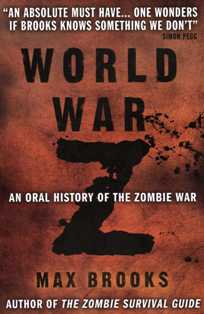
First published back in September of 2006 and following on from the huge cult success of the ‘The Zombie Survival Guide’ (2003), Max Brooks once again delves into the elaborate depths of his survivalist knowledge to unleash another complex analysis of a world threatened by the undead.
Expanding on the principle idea of a fabricated history of zombie attacks that were first utilised in the second half of ‘The Zombie Survival Guide’, Brooks this time invents a world where the reanimation of corpses via the Solanum virus has escalated to further extremities than those previously documented in the survival guide.
The sequential storyline of the book is constructed by the use of numerous (fictional) oral interviews with various members of society (army officers, teenage computer nerds, security guards, preachers etc) whose stories, when laid out end to end, form a haunting picture of the collapse and close annihilation of humankind. Each one of these interviews are predominately the story told by that particular survivor of the events they saw.
Brooks breaks the book down into chapters that adequately form the basis of the novel’s structured storyline. From a short introduction whereby Brooks sets down the premise in which the book is to be taken, the following chapter headings give a clear early on indication of how the book is to progress:
(1) Warnings (2) Blame (3) The Great Panic (4) Turning The Tide (5) Home Front USA (6) Around The World, And Above (7) Total War (8) Good-Byes
The pace of the book begins relatively slow, allowing the reader to become accustomed to the unusual set out and the surreal feel of the format that has been adopted by Brooks. As the zombie attacks begin to take on a more severe nature, so the pace of the book snowballs. Brooks lays down a judgemental analysis (or a bleak prediction?) of the government’s response to this rising epidemic. Brooks then zeroes in with a (somewhat exaggerated for effect) breakdown on humanities automatic response to the developing crisis.
Governmental bodies attempt to cover-up the truth behind the mass slaughter, stating that cases of rabies are responsible, in order to limit an all-out panic. Opportunist entrepreneurs leap at the chance to make some easy money in the panic, distributing an anti-rabies drug in the full knowledge that the outbreak has nothing to do with rabies. Approaching governmental elections are still given priority of thought during these dramatic times. Humanities years of perfecting the art of warfare is instantly made moribund against this new enemy; that in one swift motion re-defines all previous threats, turning strategies on their head and rendering the vast majority of modern weaponry useless. Office workers are now finding their previous skills and abilities useless, further turning the modern-day class structure hierarchy on its head. All around the world, every culture, every nation and every individual, responds to the outbreak in their own unique way. This is the very essence of what Brooks captures in ‘World War Z’.
Thoroughly immersing himself in the prospect of such an apocalyptic scenario, Brooks details psychological aspects of this catastrophic turn of events, that shows a depth of thinking that has previously never been incorporated into the concept of a zombie epidemic. The creation of ‘quislings’ is one such notion. These are psychologically effected individuals who, after mentally falling apart at the collapse of humanity whilst faced with the hordes of flesh eating undead, begin to believe they are in fact one of these reanimated corpses. They become so convinced, that all of their actions and reactions to their fellow survivors, mimic those of the undead. Although these are 100% living people, they form an additional threat to all other survivors.
Brooks’ humorous reference to ‘The Zombie Survival Guide’ mid-way through the novel, mentioning the previous book’s importance but limitations, not only plays a small self-homage to the book, but also gives a further depth into this fictional ‘reality’ that he is so determinedly setting down.
The novel’s projection is bleak throughout, interspersed with moments of heroic deeds and passages of inspirational defiance in the face of the zombie hordes. Although the final outcome is known to the reader from the very outset, this does not ruin the play of the book or the build up towards the eventual victory. Brooks’ chapter on ‘Total War’ is perhaps the most powerful and awe inspiring vision on an all-out response to humanities clawing back from the brink of total extinction. In this one chapter, Brooks takes the analysis of the undead enemy to its furthest reaches, for the first time really detailing what humanity would truly be up against.
All in all, ‘World War Z’ is an astonishingly detailed and well researched book, taking into account a whole world of cultures and lifestyles in order to show their response to this apocalyptic threat. This is a survivalist’s and zombie enthusiast’s wet-dream, with so much detail and psychological analysis that at times you feel dwarfed with the sheer unrelenting reality of the whole concept.
The book runs for a total of 342 pages.
© DLS Reviews






